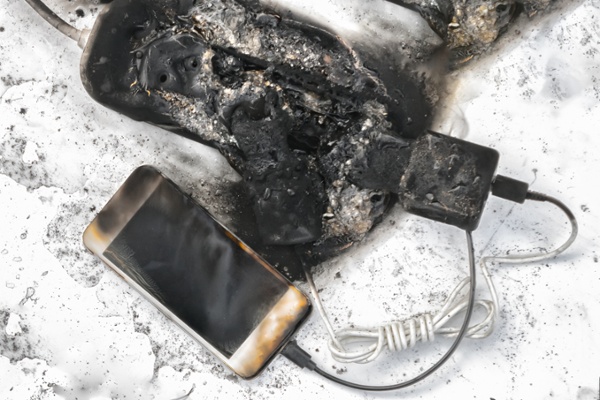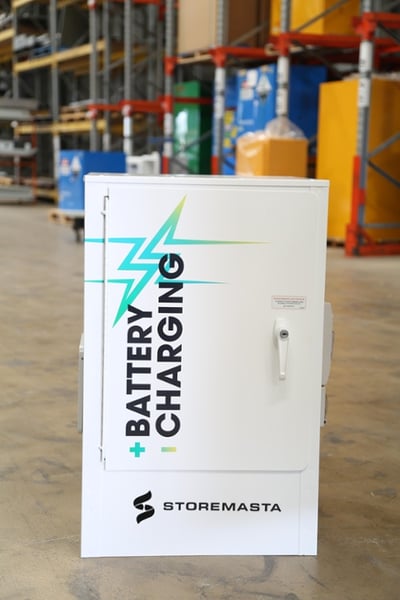Rechargeable lithium-ion batteries – otherwise known as Li-ion or LiBs – have received a lot of press over recent years, and not all the hype is favourable. Workplaces may become increasingly concerned about LiBs due to the risk of fire and explosion. So the question that we are hearing is, ‘Should workplaces consider mandatory safe storage of lithium-ion batteries to control fire risk.’ We’ll discuss some key points about Li-ion safety, as well as offer some advice on the benefits of applying safe storage to your operations.
But first, let’s have a quick look at lithium battery fires and what hazards they can pose to your organisation.
How Do LiBs Catch on Fire?
The failure of lithium-ion batteries can be caused by a wide range of events, from overheating of the cell to overcharging, using the wrong type of charger, battery defects, impact damage or system faults.
However, when a battery fire breaks out, it’s not as simple as grabbing a fire extinguisher and putting the blaze out. These batteries, unlike a fire caused by petrol or another flammable substance, create a uniquely dangerous situation for those tending to the blaze, as well as those in the workplace and surrounding community.

Battery fires have gained a lot of attention as the incidents of lithium-ion battery blazes increases with usage.
What are the Hazards of a Lithium-ion Battery Fire?
Lithium battery fires come with a wide range of challenges and hazards.
Battery fires may produce toxic gas emissions, projectiles from exploding cells and thermal runaway in any nearby battery stores. The key issue with combating lithium-ion battery fires is the risk of batteries reigniting after they have been cooled down. Special fire extinguishers or large amounts of water are the only ways that lithium-ion batteries can be cooled down enough that the risk of reignition dissipates. This creates a very dangerous situation for workplaces and fire crews who may be battling a fast burning and volatile battery blaze.
Hazards of lithium-ion battery fires include:
Physical Hazards
Staff or property being impacted by projectiles from exploding batteries, extreme heat, fire and/or explosion.
Health Hazards
Personnel and emergency services may be exposed to dangerous gas emissions, smoke, flammable electrolyte, and hydrofluoric acid if the leaked electrolyte reacts with water or moisture. If staff notice safety issues with the battery, they should never attempt to touch the LiBs without the use of personal protective equipment as contact with the cell could result in burns – or worse.
Environmental Hazards
Some types of Li-ion batteries contain environmental pollutants, such as heavy metals and toxic substances. These can escape into the environment – through drainage systems, unsealed concrete or unbunded work areas. These pollutants can then affect the health and safety of waterways, soil and the flora and fauna in that environment. The incorrect disposal of LiBs can also harm the environment, so the correct waste disposal procedures should always be followed.
Chemical Hazards
As batteries are recognised as Class 9 dangerous goods, these cells contain harmful chemicals that – in certain circumstances – can create a chemical hazard. While most lithium-ion batteries will be a safe energy source for your workplace equipment and devices, chemical hazards can occur if the cell malfunctions or is stored or handled in a way that compromises the cell. Chemicals within the battery can also react with incompatible substances in the workplace, causing further hazards.
Electrical Hazards
When a fire breaks out during the charging of a lithium-ion cell, the battery is still connected to the electrics of your building. Electrically charged equipment must not be doused with water, due to the risk of electric shock.
REMEMBER: The risks involved with your onsite lithium-ion rechargeable batteries will depend on a range of factors, including how and where the battery is being charged, what maintenance is required for the battery, and how you’re adhering to the recommendations of the manufacturer and the requirements of the safety data sheet.
Why Should My Business Consider Safe Lithium-ion Battery Storage?
Sadly, many of the hazards associated with LiBs could have been avoided if staff were aware of the correct battery management methods.
Lithium battery fires can be preventable, if the inspection, handling, transport, charging and storage of the cell is done in the safest possible way – and follows the battery manufacturer’s instructions, as well as the safety data sheet.
It’s important for all businesses who charge any type of lithium-ion battery to consider the impact that safe battery storage has on the overall health and safety of your workplace.
How Does Battery Storage Reduce Risk of Fire?
Providing optimum storage conditions for lithium-ion rechargeable batteries can greatly control the risk of fire, electrolyte leaks and other dangers.
Battery storage that is considered ‘best practice’ will align with the information in your safety data sheet. This safe battery storage will reduce the risk of fire due to the provision of:
- Adequate ventilation, which is required for charging and storage
- Correct storage temperatures to avoid battery overheating
- Isolation from moisture and humidity, as this can create battery hazards
- Removal of any heat sources or ignition sources from battery areas
- Charging of batteries in a protection position, not in direct sunlight
- Identification and isolation of incompatible materials or dangerous goods that may react with the battery
- Non-combustible, hard surface to ensure fire control during charging
- Secure, dedicated storage for use by authorised personnel only
IMPORTANT: Safe storage for batteries is an important consideration for any workplace, whether you’re using batteries to power a few items or a few hundred. However, the handling of your batteries is also integral to the safety of your cells, so make sure you develop standard operating procedures for battery handling, charging and storage.
Is Battery Storage Compulsory?
Currently, fire services, battery manufacturers and some organisations recommend following the correct protocols when storing and charging lithium-ion batteries. However, at the moment, it is not mandatory to store batteries in a safe, dedicated battery cabinet or Li-ion battery store.
Battery storage can mitigate the risks related to lithium-ion battery recharging and storage for the workplace.
At the same time, with the growing concern about battery management, it’s important to note that many organisations — both large and small — are implementing procedures to ensure that battery fires are prevented.
Our Dangerous Goods Storage Consultants have worked with many businesses who have already been affected by lithium-ion battery fires. Due to the real dangers of working with these types of energy sources, we believe safe battery storage is a key consideration for any workplace that uses these cells.
Administrative Controls for Battery Safety
In addition to safe storage — such as a dedicated Battery Charging Cabinet — we also highly recommend the development of Li-ion handling, storage and transport procedures. By developing an overall approach to battery management — with consideration to how the batteries are used and handled in your workplace — you can further reduce the likelihood of a fire occurring. Make sure your staff are aware of the dangers involved with these cells and create procedures to ensure that all hazards are controlled through correct handling and storage.
Another key consideration that can reduce fire risk is the regular inspection of batteries. Teach staff about the warning signs (ie. swollen batteries, leaking electrolyte, overheated cells etc) that may lead to a fire incident, and give them the procedures to act swifty if any issues occur. It’s important to inspect batteries regularly, particular prior to charging, as well look after and maintain all batteries, chargers and storage areas to ensure optimum health and safety.
REMEMBER: The Australian Standards offer requirements for storage and handling of dangerous goods. While there is no current Australian Standard for lithium-ion batteries, this is being developed to assist organisations in effectively reducing risk.
Considering Battery Storage?
If you’d like to learn more about the risks posed by LiBs – and how to control them - we have an easy-to-understand eBook that can help. This book guides you through some general risk identification steps for workplace batteries including lead-acid and lithium-ion cells. You can download your copy of our free eBook today to find out more about protecting your people and workplace.

Living life by the 4 C’s of marketing – communication, coffee, compliance… and more coffee – Leisa Andersen is Storemasta’s Content Marketing Manager. When she’s not writing, you’ll find her enjoying all the good things in life, including shopping, travel and gluten free donuts.


